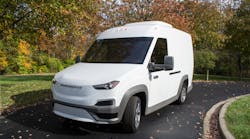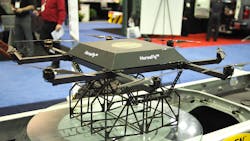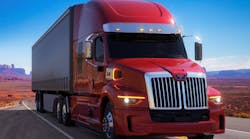Workhorse Group Inc. is official kicking off a pilot test program in “several major cities” this week of its new N-Gen electric van equipped with an optional HorseFly unmanned aerial vehicle or “drone” for delivering packages weighing up to 10 lbs.
In an interview with Fleet Owner, Stephen Burns, CEO of Workhorse, explained that a fully-integrated van/drone package is designed to address the single biggest cost of last-mile delivery service: driver time.
He explained that it costs roughly $40 per hour for drivers to conduct house-to-house package delivery in suburban and rural areas – covering on average about 65 miles in a day.
Thus increasing the ability of delivery drivers to make more deliveries during their day via the use of a drone should boast productivity “significantly,” Burns said, thus lowering costs.
He also noted that using an all-electric vehicle platform in combination with a drone lowers vehicle operating costs significantly as well.
“The rule of thumb is that a diesel vehicle costs about $1 a mile to operate, whereas an electric truck costs 25 cents a mile,” Burns pointed out. “Then there is a drone, which costs 3 cents per mile.”
The anticipated range of the electric N-Gen van, which is fitted with a “lightweight composite body,” is 100 miles on a single charge. Workhorse said. The addition of an optional gasoline engine should add another 75 miles to that range, according to the company.
The vehicle maker added that, in early on-road testing, the N-Gen is demonstrating fuel efficiency of 60 to 65 miles per gallon/electric (MPGe).
Workhorse has also lowered the floor of its N-Gen van to 19-in., which, in combination with a 105-in. roof height, should not only increase available cargo space but reduce knee injuries and enhance driver “ease of operation.”
Burns noted that as a finalist for the U.S. Postal Service’s vehicle replacement contract (they are a subcontractor for the bid by VT Hackney) Workhorse has conducted a lot of research into the “package delivery ergonomics” of U.S. mail carriers, who make hundreds of stops per day, and figures Workhorse’s new floor design should significantly reduce the potential for on-the-job injuries.
That dovetails with research findings detailed by the Bureau of Labor Statistics (BLS) two years ago, which found that the majority of non-fatal injuries and illnesses among delivery drivers are not related to “transportation incidents” such as vehicle collisions and other crashes.
Only 13% of the injuries and illnesses were due to such “transportation incidents,” the BLS said, which trailed overexertion and bodily reaction (41%); falls, slips, and trips (23%); and contact with object or equipment (19%).
Adding the HorseFly drone should also aid in reducing that potential for on-the-job injuries, Burns said. With the carbon-fiber, octocopter HorseFly drone operating within the driver’s line of sight at a maximum distance of a mile and a half, a driver could park in one location and make deliveries to several homes while minimizing the entry and egress required from the van to do so.
Other details regarding the N-Gen van now being pilot tested include:
- Standard van options include all-wheel drive plus automatic braking and “lane centering” safety technology packages;
- The vehicle offers a 26-foot turning radius to improve maneuvering capability in tight suburban locales;
- Ryder System is the primary distributor and service support provider for Workhorse light and medium duty range-extended electric vehicles in North America, which will include the N-Gen.
- The N-Gen features the built-in Workhorse Metron telematics system, which tracks in real time all van and drone parameters so as to “optimize” performance and efficiency.
- Additional configurations for telecomm service and municipal use, as well as 700-cubic-ft. and 1,000-cubic-ft. models, are expected in late 2018, Workhorse added.
Burns noted that the idea of using drone-equipped vans to conduct last-mile delivery operations is really only envisioned for suburban and rural areas, not the inner-city.
He added, too, that the package delivery industry is rapidly expanding the realm of possibilities where such drone-equipped vehicles are concerned.
“Right now, the vehicle must be stationary in order to use the drone,” Burns said.
“But now many [delivery] companies are asking if the van can be moving, with multiple drones making multiple deliveries as it rolls through a neighborhood,” he pointed out. “We’ve gone from doubts about using drones to deliver packages at all to asking if we can park two or three on the roof. This is how rapidly the idea is taking hold.”




